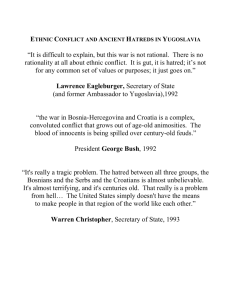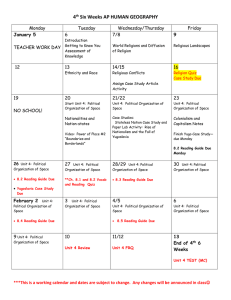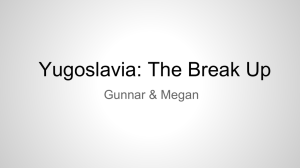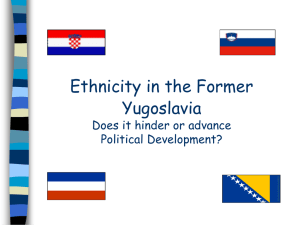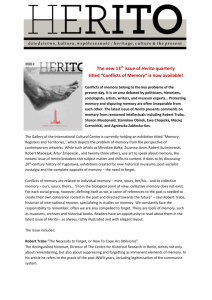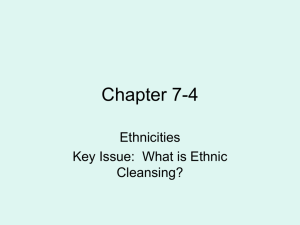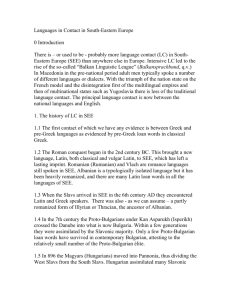conflicts in the balkans oct07
advertisement
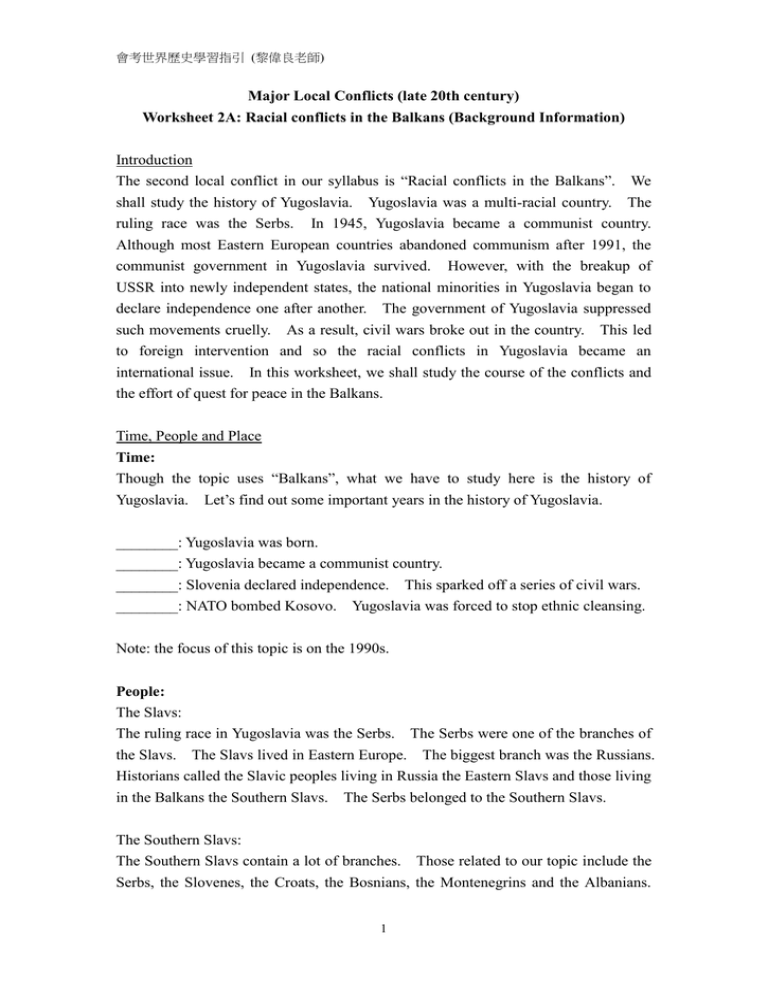
會考世界歷史學習指引 (黎偉良老師) Major Local Conflicts (late 20th century) Worksheet 2A: Racial conflicts in the Balkans (Background Information) Introduction The second local conflict in our syllabus is “Racial conflicts in the Balkans”. We shall study the history of Yugoslavia. Yugoslavia was a multi-racial country. The ruling race was the Serbs. In 1945, Yugoslavia became a communist country. Although most Eastern European countries abandoned communism after 1991, the communist government in Yugoslavia survived. However, with the breakup of USSR into newly independent states, the national minorities in Yugoslavia began to declare independence one after another. The government of Yugoslavia suppressed such movements cruelly. As a result, civil wars broke out in the country. This led to foreign intervention and so the racial conflicts in Yugoslavia became an international issue. In this worksheet, we shall study the course of the conflicts and the effort of quest for peace in the Balkans. Time, People and Place Time: Though the topic uses “Balkans”, what we have to study here is the history of Yugoslavia. Let’s find out some important years in the history of Yugoslavia. ________: Yugoslavia was born. ________: Yugoslavia became a communist country. ________: Slovenia declared independence. This sparked off a series of civil wars. ________: NATO bombed Kosovo. Yugoslavia was forced to stop ethnic cleansing. Note: the focus of this topic is on the 1990s. People: The Slavs: The ruling race in Yugoslavia was the Serbs. The Serbs were one of the branches of the Slavs. The Slavs lived in Eastern Europe. The biggest branch was the Russians. Historians called the Slavic peoples living in Russia the Eastern Slavs and those living in the Balkans the Southern Slavs. The Serbs belonged to the Southern Slavs. The Southern Slavs: The Southern Slavs contain a lot of branches. Those related to our topic include the Serbs, the Slovenes, the Croats, the Bosnians, the Montenegrins and the Albanians. 1 會考世界歷史學習指引 (黎偉良老師) Unlike the Arabs who share a common language, the Slavs do not have a single language. They have to rely on translators when speaking with other branches. This is similar to the Hans (Chinese). The Hans living in different regions in China speak different dialects. Fortunately, the Hans have a common written language. However, this is not the case for the Slavs. Place: Let’s use the following map exercises to find out how Yugoslavia evolved into a multi-racial country. Stage 1 (before 1878) Before 1878, the Serbs and other Southern Slavs did not have their own countries. They lived in the Balkan Peninsula and were under foreign rule. Those branches under Turkish rule included: _____________________________________________________________________ _____________________________________________________________________ Those branches under the rule of Austria-Hungary included: _____________________________________________________________________ _____________________________________________________________________ For religion, the Southern Slavs believed in Eastern Orthodoxy (a branch of Christianity). However, since they were ruled by the Turks who believed in Islam and the Austrians who believed in Catholic, some Southern Slavs were converted into these religions. The Slovenes and the Croats believed in Catholic and some Bosnians believed in Islam. The Serbs remained as Eastern Orthodoxy. Thus, racial conflicts in Yugoslavia also contained religious conflicts. 2 會考世界歷史學習指引 (黎偉良老師) Exercise 1 1. Refer to Source 72 on page 138, write down the names of the Southern Slavic peoples on the location where they lived. (Note: the place where the Slovenes lived is outside the map area.) 2. Use different colors to mark the Turkish Empire and Austria-Hungary. 3 會考世界歷史學習指引 (黎偉良老師) Stage 2 (1878-1913) In 1875, the Serbs, Montenegrins and Bosnians revolted against Turkish rule. With Russian help, Serbia and Montenegro gained independence. The Bosnians were put under Austrian rule. Exercise 2 Mark Serbia and Montenegro in different colors. 4 會考世界歷史學習指引 (黎偉良老師) Stage 3 (1913-1919) In 1913, Serbia and other Balkan states defeated Turkey and got Macedonia. Albania became independent. Montenegro also got some territories. However, Bosnia formally became part of Austria-Hungary five years before (1908). The size of Serbia doubled. Now, national minority appeared in the country. This sowed the seeds of future racial conflicts. The first national minority in Serbia was _____________________. Exercise 3 Mark Serbia, Montenegro and Albania in different colors. 5 會考世界歷史學習指引 (黎偉良老師) Stage 4 (1919-1991) Serbia was a winner in the First World War but Austria-Hungary was a loser. After the war, the Slovenes, Croats and Bosnians broke away from Austria-Hungary. However, under the pressure from Serbia, the Big Three in the Paris Peace Conference did not allow these peoples to become independent. They were put under Serbian rule. Montenegro was given to Serbia. The Serbs now believed that they had united all the Southern Slavs. Later, they changed the name of their country into Yugoslavia. The word “Yugoslavia” literally means “Southern Slavs”. From then on, Yugoslavia became a multi-racial country. Exercise 4 Mark the boundary of Yugoslavia in red. 6 會考世界歷史學習指引 (黎偉良老師) Early racial conflicts in Yugoslavia (1919-1991) You might ask, “Since Yugoslavia had been a multi-racial country in 1919, why didn’t racial conflicts break out in 1919 instead of 1991?” Let’s find out the answer. In fact, small racial conflicts had already broken out in 1920s and 1930s. Yet, the invasion of Germany in 1941 prevented such small conflicts from developing into major conflicts. Under the cruel rule of Nazi Germany, the races in Yugoslavia put aside their conflicts and united together to overthrow German rule. It was at this time that a national hero appeared. He was called Tito. His popularity delayed the outbreak of racial conflicts in Yugoslavia. Why could Tito delay the outbreak of racial conflicts in Yugoslavia? 1. The popularity of Tito During World War II: _____________________________________________________________________ _____________________________________________________________________ _____________________________________________________________________ After World War II: _____________________________________________________________________ _____________________________________________________________________ _____________________________________________________________________ 2. Tito’s rule _____________________________________________________________________ _____________________________________________________________________ _____________________________________________________________________ Analysis of racial conflicts in Yugoslavia Why did racial conflicts intensified? 1. The death of Tito Elaboration: _____________________________________________________________________ _____________________________________________________________________ _____________________________________________________________________ 2. The breakup of USSR Elaboration: _____________________________________________________________________ _____________________________________________________________________ _____________________________________________________________________ 7 會考世界歷史學習指引 (黎偉良老師) Getting ready for the study of racial conflicts in Yugoslavia The textbook uses 2 full pages to describe the course of racial conflicts in Yugoslavia (in small fonts). Some independent movements were relatively more peaceful while some involved brutal killing and wars. It is quite difficult to remember. However, if we think more and make use of the data provided in the textbook, we can memorize such facts in a systematic way and will not forget them so easily. Refer to source 72 on page 138. It is not very difficult to remember facts such as which country became independent first or last, or which independent movement was relatively peaceful and which involved lots of killing. Let’s do the following exercises. 1. What is the relation between difference in Serb-national minority population distribution and the difficulty in getting independence? _____________________________________________________________________ _____________________________________________________________________ _____________________________________________________________________ What was the difference (in percentage) between the population of the Serbs and national minorities in the following places? Slovenia: ______________ Croatia:________________ Bosnia: ________________ Montenegro:____________ Macedonia:_____________ Difference that is greater than 60% includes the following places: _____________________________________________________________________ Difference that is less than 60% includes the following places: _____________________________________________________________________ Thus, it is easier for the following places to gain independence: _____________________________________________________________________ 2. What is the relation between distance from Serbia and the difficulty in getting independence? _____________________________________________________________________ _____________________________________________________________________ _____________________________________________________________________ 8 會考世界歷史學習指引 (黎偉良老師) Places that do not share a common border with Serbia includes: _____________________________________________________________________ Places that share a common border with Serbia includes: _____________________________________________________________________ Thus, it is easier for the following places to gain independence: _____________________________________________________________________ Considering the two factors listed above, what do you think the order of these places to gain independence should be: _____________________________________________________________________ What was the order according to historical facts? _____________________________________________________________________ _____________________________________________________________________ Now, we are ready to study Worksheet 2B to find out the course of racial conflicts in Yugoslavia and the quest for peace. 9
